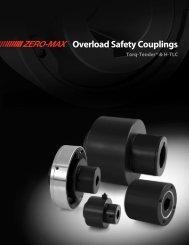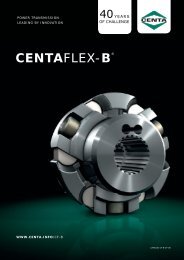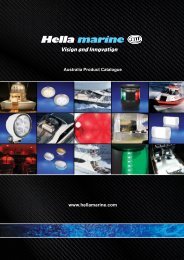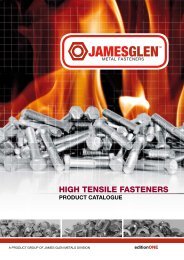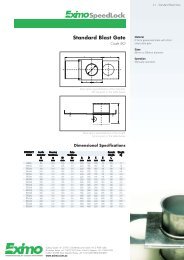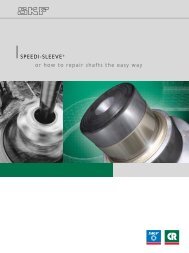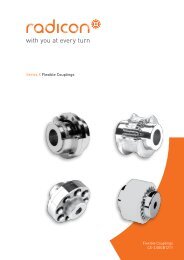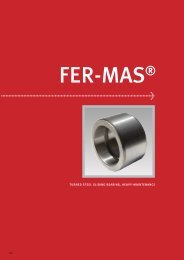Download - Industrial and Bearing Supplies
Download - Industrial and Bearing Supplies
Download - Industrial and Bearing Supplies
You also want an ePaper? Increase the reach of your titles
YUMPU automatically turns print PDFs into web optimized ePapers that Google loves.
138 LED Technology<br />
TECHNICAL<br />
An LED (Light Emitting Diode) is a solid state<br />
electronic device that consists of several<br />
layers of semiconductor material, in contrast<br />
to a lamp that consists of a glass envelope<br />
<strong>and</strong> electrodes assembled into a base. The<br />
mechanically robust nature <strong>and</strong> low voltage<br />
operation inherent in LED technology makes it<br />
attractive to use in many lighting applications.<br />
LED benefits<br />
LED Technology has enormous benefits for<br />
the mining industry, the most obvious being<br />
the reduction in maintenance requirements<br />
of our “fit <strong>and</strong> forget” design principle that<br />
reduces vehicle servicing down times, as<br />
there are no globes to burn out or holders to<br />
corrode.<br />
Hella LED lamps are pre-wired for easy<br />
installation <strong>and</strong> manufactured to offer<br />
maximum impact resistance <strong>and</strong> high<br />
tolerance to chemicals, salt spray <strong>and</strong><br />
cleaning fluids. Most of the LED products<br />
offered can survive shock impulses of 200G,<br />
<strong>and</strong> operate over a much wider range of<br />
ambient temperatures than normal products.<br />
LED technology<br />
Unlike conventional lamps that produce a<br />
broad spectrum of colours (white light), an<br />
LED emits light only in a particular single<br />
colour. The specific colour is dependent on<br />
the semiconductor material system used<br />
(AllnGaP <strong>and</strong> InGaN) <strong>and</strong> ranges from red<br />
through amber, green <strong>and</strong> blue. Creating a<br />
coloured light signal from a conventional<br />
globe requires the use of a filter (generally a<br />
coloured lens) that absorbs most of the light<br />
<strong>and</strong> passes through only the desired colour<br />
spectrum. The filter losses normally range<br />
from 30% to 80% depending on the colour<br />
<strong>and</strong> intensity requirements. LED technology<br />
eliminates this inefficient process. Hella LED<br />
signal <strong>and</strong> warning lamps operate with up to<br />
60% less current draw than comparable globe<br />
lamps.<br />
White light from an LED is produced by one of<br />
two methods. The most common is a process<br />
of luminescence conversion where a blue LED<br />
light excites a phosphor to emit yellow light,<br />
the mixture resulting in white light. The other<br />
process of RGB colour mixing uses individual<br />
red, green <strong>and</strong> blue LEDs <strong>and</strong> by altering the<br />
relative mix of the three primary colours, any<br />
other colour including white can be created.<br />
The efficiency of white LEDs has risen<br />
considerably over the past few years; values<br />
of 50 lm/W <strong>and</strong> more are now being achieved.<br />
It is now possible to produce white LED<br />
lights that are more efficient than Halogen<br />
<strong>and</strong> inc<strong>and</strong>escent lamps, but still significantly<br />
less efficient than gas discharge lamps. The<br />
relatively high cost of high-efficiency white<br />
LEDs still limits their use to applications where<br />
a small amount of light with minimal heat is<br />
required, areas where mechanical damage<br />
due to shock <strong>and</strong> vibration destroys other<br />
lights, or where the safety of low voltage<br />
operation is paramount.<br />
LED temperature behaviour<br />
The amount of light emitted by an LED<br />
reduces as the temperature rises:<br />
yellow LEDs are more affected by high<br />
temperatures than green <strong>and</strong> blue<br />
LEDs. Loss of output as a result of high<br />
temperature reverses when the LED<br />
cools down <strong>and</strong> should not be confused<br />
with degradation which happens over a<br />
long time or in lamps in which LEDs are<br />
operated beyond<br />
their design current.<br />
LED product<br />
design<br />
The high efficiency,<br />
low power dem<strong>and</strong><br />
that Hella LED lamps<br />
are known for is not<br />
an automatic result of<br />
using LED technology.<br />
Many competitor<br />
products are no more<br />
efficient or durable than conventional<br />
lights. Hella invests considerable time <strong>and</strong><br />
diligence into the four most significant<br />
aspects of LED product design, thereby<br />
producing award winning, class-leading,<br />
innovative products that set new st<strong>and</strong>ards<br />
<strong>and</strong> receive worldwide recognition.<br />
The most important issue relates to the<br />
selection <strong>and</strong> optimum application of LED<br />
devices suited to each task. Like all electronic<br />
components, LEDs are mass-produced, with<br />
each production batch yielding LEDs that vary<br />
enormously in efficiency <strong>and</strong> colour. As one<br />
of the largest global users of high intensity<br />
LEDs, Hella has developed sophisticated<br />
techniques that enable us to select only the<br />
most efficient LEDs that fall within very tight<br />
colour specification parameters.<br />
The second aspect depends on maximising<br />
optical system efficiency. Individual LED<br />
devices typically produce a hundred times<br />
less light than a conventional light globe.<br />
To use the light effectively requires highly<br />
meticulous optical system design.<br />
The third aspect relates to effective power<br />
supply <strong>and</strong> control circuit designs. LEDs<br />
are much more sensitive to heat <strong>and</strong><br />
electrical issues than conventional lamps.<br />
The development of robust, efficient circuits<br />
that manage the operation of LEDs is just as<br />
important as the optical aspects. Years of<br />
experience gained through the production<br />
<strong>and</strong> worldwide use of millions of LED<br />
lights, enables Hella to keep<br />
delivering<br />
innovative <strong>and</strong><br />
effective solutions<br />
to the challenges<br />
faced by LED<br />
systems.<br />
The final aspect is<br />
the physical product<br />
design. All the<br />
mechanical, thermal<br />
management <strong>and</strong> operational environment<br />
<strong>and</strong> production requirements are integrated<br />
into a robust product that is expected to<br />
remain fully operational under severe cold,<br />
heat <strong>and</strong> humidity, while also being subjected<br />
to high levels of vibration. Hella backs up<br />
our innovative physical design <strong>and</strong> assembly<br />
processes with a large investment in extensive<br />
in-house test <strong>and</strong> development facilities to<br />
prove all of our products meet the dem<strong>and</strong>s<br />
placed on them in the field.<br />
®




